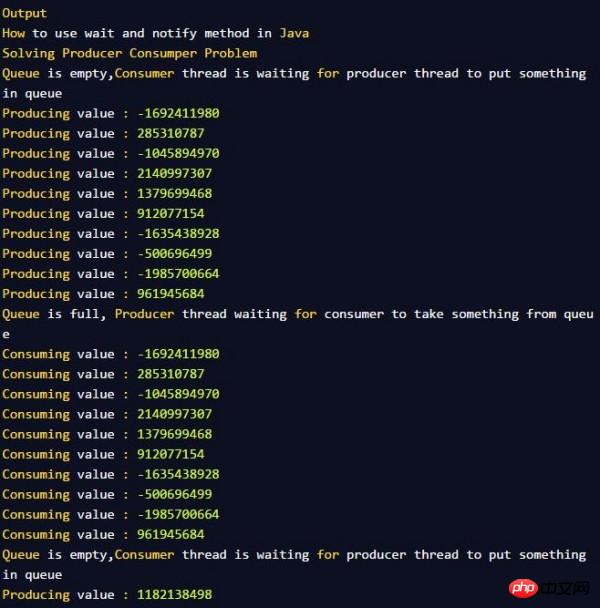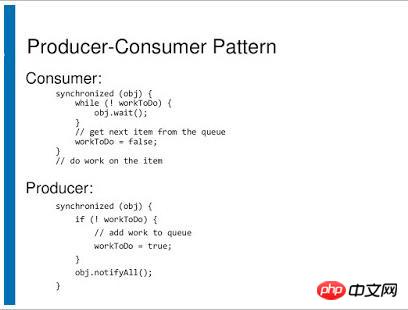Correct usage of wait, notify and notifyAll
In Java, you can use wait, notify and notifyAll to achieve communication between threads. . For example, if you have two threads in your Java program - a producer and a consumer, then the producer can notify the consumer to start consuming data because there is content in the queue buffer to be consumed (not for null). Accordingly, the consumer can notify the producer that it can start generating more data because the buffer is no longer full after it has consumed some data.
wait, notify and notifyAll, these reserved keywords that are often used in multi-threading, are often not taken seriously during actual development. This article describes the use of these keywords.
In Java, you can use wait, notify and notifyAll to achieve communication between threads. . For example, if you have two threads in your Java program - a producer and a consumer, then the producer can notify the consumer to start consuming data because there is content in the queue buffer to be consumed (not for null). Accordingly, the consumer can notify the producer that it can start generating more data because the buffer is no longer full after it has consumed some data.
We can use wait() to pause a thread under certain conditions. For example, in the producer-consumer model, the producer thread should pause when the buffer is full and the consumer thread is empty. If some threads are waiting for certain conditions to trigger, then when those conditions are true, you can use notify and notifyAll to notify the waiting threads to start running again. The difference is that notify only notifies one thread, and we don't know which thread will receive the notification, while notifyAll will notify all waiting threads. In other words, if there is only one thread waiting for a semaphore, both notify and notifyAll will notify this thread. But if multiple threads are waiting for this semaphore, notify will only notify one of them, and other threads will not receive any notification, and notifyAll will wake up all waiting threads.
In this article you will learn how to use wait, notify and notifyAll to implement communication between threads to solve the producer-consumer problem. If you want to learn more about multi-thread synchronization issues in Java, I highly recommend reading "Java Concurrency in Practice | Java Concurrency Practice" by Brian Goetz. Your Java multi-threading journey is incomplete without reading this book. oh! This is one of my most recommended books for Java developers.
How to use Wait
Although the concepts of wait and notify are very basic and they are also functions of the Object class, it is not simple to use them to write code. . If you ask candidates to hand-write code during interviews and use wait and notify to solve producer-consumer problems, I am almost certain that most of them will be at a loss or make some mistakes, such as using the synchronized keyword in the wrong place. Not using wait on the correct object, or not following the standard code approach. To be honest, this problem is indeed a headache for programmers who don't often use them.
The first question is, how do we use wait() in the code? Because wait() is not a function under the Thread class, we cannot use Thread.call(). In fact, many Java programmers like to write like this, because they are used to using Thread.sleep(), so they will try to use wait() to achieve the same purpose, but they will soon find that this does not solve the problem smoothly. The correct method is to use wait on the Object shared between multiple threads. In the producer-consumer problem, this shared Object is the buffer queue.
The second question is, since we should call wait in a synchronized function or object, which object should be synchronized? The answer is that the object you want to lock should be synchronized, that is, the object that is shared among multiple threads. In the producer-consumer problem, what should be synchronized is the buffer queue. (I think there is something wrong with the original English text... There shouldn't be a question mark at the end of the sentence, otherwise it doesn't make sense...)

is always called in a loop wait and notify, not in If statement
现在你知道wait应该永远在被synchronized的背景下和那个被多线程共享的对象上调用,下一个一定要记住的问题就是,你应该永远在 while循环,而不是if语句中调用wait。因为线程是在某些条件下等待的——在我们的例子里,即“如果缓冲区队列是满的话,那么生产者线程应该等 待”,你可能直觉就会写一个if语句。但if语句存在一些微妙的小问题,导致即使条件没被满足,你的线程你也有可能被错误地唤醒。所以如果你不在线程被唤 醒后再次使用while循环检查唤醒条件是否被满足,你的程序就有可能会出错——例如在缓冲区为满的时候生产者继续生成数据,或者缓冲区为空的时候消费者 开始小号数据。所以记住,永远在while循环而不是if语句中使用wait!我会推荐阅读《Effective Java》,这是关于如何正确使用wait和notify的最好的参考资料。
基于以上认知,下面这个是使用wait和notify函数的规范代码模板:
// The standard idiom for calling the wait method in Java
synchronized (sharedObject) {
while (condition) {
sharedObject.wait();
// (Releases lock, and reacquires on wakeup)
}
// do action based upon condition e.g. take or put into queue
}就像我之前说的一样,在while循环里使用wait的目的,是在线程被唤醒的前后都持续检查条件是否被满足。如果条件并未改变,wait被调用之前notify的唤醒通知就来了,那么这个线程并不能保证被唤醒,有可能会导致死锁问题。
Java wait(), notify(), notifyAll() 范例
下面我们提供一个使用wait和notify的范例程序。在这个程序里,我们使用了上文所述的一些代码规范。我们有两个线程,分别名为 PRODUCER(生产者)和CONSUMER(消费者),他们分别继承了了Producer和Consumer类,而Producer和 Consumer都继承了Thread类。Producer和Consumer想要实现的代码逻辑都在run()函数内。Main线程开始了生产者和消费 者线程,并声明了一个LinkedList作为缓冲区队列(在Java中,LinkedList实现了队列的接口)。生产者在无限循环中持续往 LinkedList里插入随机整数直到LinkedList满。我们在while(queue.size == maxSize)循环语句中检查这个条件。请注意到我们在做这个检查条件之前已经在队列对象上使用了synchronized关键词,因而其它线程不能在 我们检查条件时改变这个队列。如果队列满了,那么PRODUCER线程会在CONSUMER线程消耗掉队列里的任意一个整数,并用notify来通知 PRODUCER线程之前持续等待。在我们的例子中,wait和notify都是使用在同一个共享对象上的。
import java.util.LinkedList;
import java.util.Queue;
import java.util.Random;
/**
* Simple Java program to demonstrate How to use wait, notify and notifyAll()
* method in Java by solving producer consumer problem.
*
* @author Javin Paul
*/
public class ProducerConsumerInJava {
public static void main(String args[]) {
System.out.println("How to use wait and notify method in Java");
System.out.println("Solving Producer Consumper Problem");
Queue<Integer> buffer = new LinkedList<>();
int maxSize = 10;
Thread producer = new Producer(buffer, maxSize, "PRODUCER");
Thread consumer = new Consumer(buffer, maxSize, "CONSUMER");
producer.start(); consumer.start(); }
}
/**
* Producer Thread will keep producing values for Consumer
* to consumer. It will use wait() method when Queue is full
* and use notify() method to send notification to Consumer
* Thread.
*
* @author WINDOWS 8
*
*/
class Producer extends Thread
{ private Queue<Integer> queue;
private int maxSize;
public Producer(Queue<Integer> queue, int maxSize, String name){
super(name); this.queue = queue; this.maxSize = maxSize;
}
@Override public void run()
{
while (true)
{
synchronized (queue) {
while (queue.size() == maxSize) {
try {
System.out .println("Queue is full, " + "Producer thread waiting for " + "consumer to take something from queue");
queue.wait();
} catch (Exception ex) {
ex.printStackTrace(); }
}
Random random = new Random();
int i = random.nextInt();
System.out.println("Producing value : " + i); queue.add(i); queue.notifyAll();
}
}
}
}
/**
* Consumer Thread will consumer values form shared queue.
* It will also use wait() method to wait if queue is
* empty. It will also use notify method to send
* notification to producer thread after consuming values
* from queue.
*
* @author WINDOWS 8
*
*/
class Consumer extends Thread {
private Queue<Integer> queue;
private int maxSize;
public Consumer(Queue<Integer> queue, int maxSize, String name){
super(name);
this.queue = queue;
this.maxSize = maxSize;
}
@Override public void run() {
while (true) {
synchronized (queue) {
while (queue.isEmpty()) {
System.out.println("Queue is empty," + "Consumer thread is waiting" + " for producer thread to put something in queue");
try {
queue.wait();
} catch (Exception ex) {
ex.printStackTrace();
}
}
System.out.println("Consuming value : " + queue.remove()); queue.notifyAll();
}
}
}
}
为了更好地理解这个程序,我建议你在debug模式里跑这个程序。一旦你在debug模式下启动程序,它会停止在PRODUCER或者 CONSUMER线程上,取决于哪个线程占据了CPU。因为两个线程都有wait()的条件,它们一定会停止,然后你就可以跑这个程序然后看发生什么了 (很有可能它就会输出我们以上展示的内容)。你也可以使用Eclipse里的Step into和Step over按钮来更好地理解多线程间发生的事情。
本文重点:
1. 你可以使用wait和notify函数来实现线程间通信。你可以用它们来实现多线程(>3)之间的通信。
2. 永远在synchronized的函数或对象里使用wait、notify和notifyAll,不然Java虚拟机会生成 IllegalMonitorStateException。
3. 永远在while循环里而不是if语句下使用wait。这样,循环会在线程睡眠前后都检查wait的条件,并在条件实际上并未改变的情况下处理唤醒通知。
4. 永远在多线程间共享的对象(在生产者消费者模型里即缓冲区队列)上使用wait。
5. 基于前文提及的理由,更倾向用 notifyAll(),而不是 notify()。

这是关于Java里如何使用wait, notify和notifyAll的所有重点啦。你应该只在你知道自己要做什么的情况下使用这些函数,不然Java里还有很多其它的用来解决同步问题的方 案。例如,如果你想使用生产者消费者模型的话,你也可以使用BlockingQueue,它会帮你处理所有的线程安全问题和流程控制。如果你想要某一个线 程等待另一个线程做出反馈再继续运行,你也可以使用CycliBarrier或者CountDownLatch。如果你只是想保护某一个资源的话,你也可 以使用Semaphore。
相关文章:
Comparison of java notify and notifyAll Detailed introduction
Two ways of collaboration between threads in java concurrency: wait, notify, notifyAll and Condition
Discuss the essential difference between notify() and notifyAll() through examples
The above is the detailed content of Correct usage of wait, notify and notifyAll. For more information, please follow other related articles on the PHP Chinese website!

Hot AI Tools

Undresser.AI Undress
AI-powered app for creating realistic nude photos

AI Clothes Remover
Online AI tool for removing clothes from photos.

Undress AI Tool
Undress images for free

Clothoff.io
AI clothes remover

AI Hentai Generator
Generate AI Hentai for free.

Hot Article

Hot Tools

Notepad++7.3.1
Easy-to-use and free code editor

SublimeText3 Chinese version
Chinese version, very easy to use

Zend Studio 13.0.1
Powerful PHP integrated development environment

Dreamweaver CS6
Visual web development tools

SublimeText3 Mac version
God-level code editing software (SublimeText3)

Hot Topics
 1385
1385
 52
52
 Perfect Number in Java
Aug 30, 2024 pm 04:28 PM
Perfect Number in Java
Aug 30, 2024 pm 04:28 PM
Guide to Perfect Number in Java. Here we discuss the Definition, How to check Perfect number in Java?, examples with code implementation.
 Weka in Java
Aug 30, 2024 pm 04:28 PM
Weka in Java
Aug 30, 2024 pm 04:28 PM
Guide to Weka in Java. Here we discuss the Introduction, how to use weka java, the type of platform, and advantages with examples.
 Smith Number in Java
Aug 30, 2024 pm 04:28 PM
Smith Number in Java
Aug 30, 2024 pm 04:28 PM
Guide to Smith Number in Java. Here we discuss the Definition, How to check smith number in Java? example with code implementation.
 Java Spring Interview Questions
Aug 30, 2024 pm 04:29 PM
Java Spring Interview Questions
Aug 30, 2024 pm 04:29 PM
In this article, we have kept the most asked Java Spring Interview Questions with their detailed answers. So that you can crack the interview.
 Break or return from Java 8 stream forEach?
Feb 07, 2025 pm 12:09 PM
Break or return from Java 8 stream forEach?
Feb 07, 2025 pm 12:09 PM
Java 8 introduces the Stream API, providing a powerful and expressive way to process data collections. However, a common question when using Stream is: How to break or return from a forEach operation? Traditional loops allow for early interruption or return, but Stream's forEach method does not directly support this method. This article will explain the reasons and explore alternative methods for implementing premature termination in Stream processing systems. Further reading: Java Stream API improvements Understand Stream forEach The forEach method is a terminal operation that performs one operation on each element in the Stream. Its design intention is
 TimeStamp to Date in Java
Aug 30, 2024 pm 04:28 PM
TimeStamp to Date in Java
Aug 30, 2024 pm 04:28 PM
Guide to TimeStamp to Date in Java. Here we also discuss the introduction and how to convert timestamp to date in java along with examples.
 Java Program to Find the Volume of Capsule
Feb 07, 2025 am 11:37 AM
Java Program to Find the Volume of Capsule
Feb 07, 2025 am 11:37 AM
Capsules are three-dimensional geometric figures, composed of a cylinder and a hemisphere at both ends. The volume of the capsule can be calculated by adding the volume of the cylinder and the volume of the hemisphere at both ends. This tutorial will discuss how to calculate the volume of a given capsule in Java using different methods. Capsule volume formula The formula for capsule volume is as follows: Capsule volume = Cylindrical volume Volume Two hemisphere volume in, r: The radius of the hemisphere. h: The height of the cylinder (excluding the hemisphere). Example 1 enter Radius = 5 units Height = 10 units Output Volume = 1570.8 cubic units explain Calculate volume using formula: Volume = π × r2 × h (4
 How to Run Your First Spring Boot Application in Spring Tool Suite?
Feb 07, 2025 pm 12:11 PM
How to Run Your First Spring Boot Application in Spring Tool Suite?
Feb 07, 2025 pm 12:11 PM
Spring Boot simplifies the creation of robust, scalable, and production-ready Java applications, revolutionizing Java development. Its "convention over configuration" approach, inherent to the Spring ecosystem, minimizes manual setup, allo




